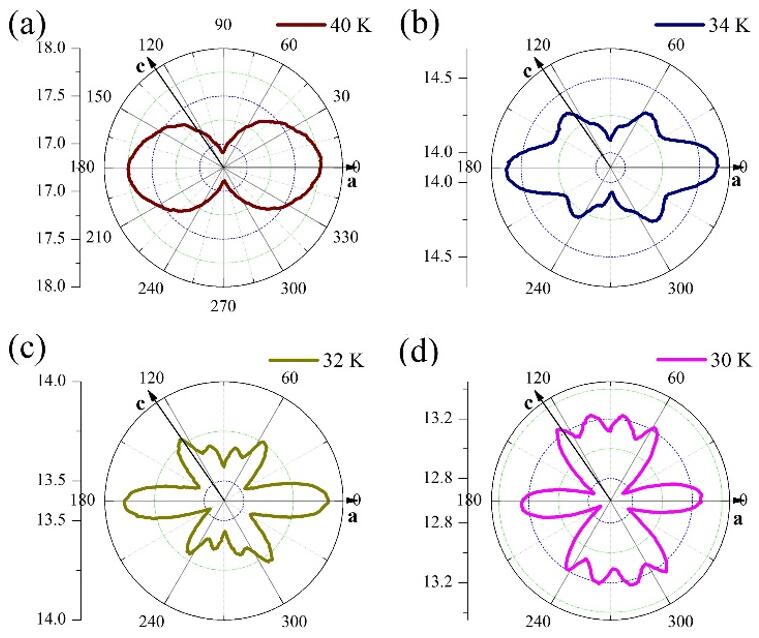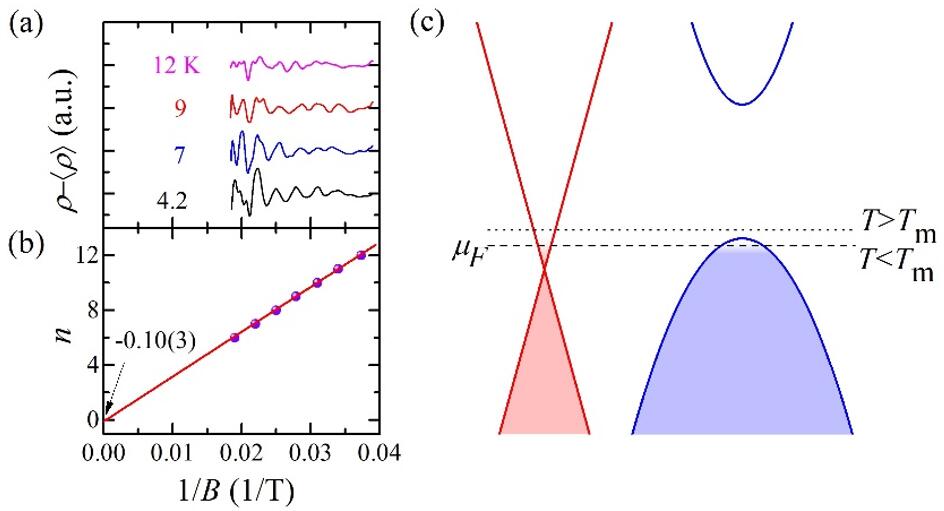
Figure 1 Angular dependence of magneto-resistance (ADMR) of W2As3 at selected temperatures.

Figure 2 (a-b) Quantum oscillations and Landau levels of W2As3. (c) A schematic band structure of W2As3. The chemical potential moves up as T increases, and is away from the hole band when T>Tm, which causes a Lifshitz transition.
(NPJ quantum materials 4, 58 (2019), DOI:https://doi.org/10.1038/s41535-019-0197-5)
Background
A Lifshitz transition means an abrupt change of the Fermi surface topology of metals without symmetry breaking,therefore, it is also termed as electronic topological transition. Conventional Lifshitz transition is quantum phase transition at zero temperature, driven by chemical doping, magneticfield, pressure or uniaxial stress, in the vicinity of which the topology of the Fermi surface deforms. Besides those quantum control parameters, temperature can be regarded as another driving force to induce a Lifshitz transition, because the chemical potential (μF) is temperature dependence and its shift can modify the Fermi surface structure. However, such realistic examples are raredue to the stringent requirements: (i) small Fermi energy (εF in the order of kBT< 100 meV), so that the varying temperature can be influential to μF with respect to εF; (ii) band structure near the Fermi energy displaying anomalous dispersion, so that the contoured Fermi surface experiences an abrupt change.
What we discover?
Here, we report studies of the angle-dependent MR (ADMR) and the thermoelectric effect in W2As3single crystal. The compound shows a large unsaturated MR (of about 7000% at 4.2 K and 53 T). The most strikingfinding is that the ADMR significantly deforms from the horizontal dumbbell-like shape above 40 K to the vertical lotus-like pattern below 30 K. The window of 30–40 K also corresponds substantial changes in Hall effect, thermopower and Nernst coefficient, implying an abrupt change of Fermi surface topology. Such a temperature-induced Lifshitz transition results in a compensation of electron-hole transport and the large MR as well. We thus suggest that the similar method can be applicable in detecting a Fermi-surface change of a variety of quantum states when a direct Fermi-surface measurement is not possible.
Why is this important?
This work is important for the reasons below. A common feature of those topological semimetals is the extremely large magnetoresistance whose origin remains elusive. The two main scenarios areincluding conventional electron-hole compensation, topological protection. Experimentally how to tell them apart is challenging. Naively, one would propose in such a way that whether the MR remains large once the electron-hole compensation shuts down. In this work, we demonstrate a temperature-induced Lifshitz transition near 30-40 K, above which the topologically trivial hole band disappears, left only the topologically non-trivial electron band. We find the extremely large MR also disappears above Tm. This manifests the important role to MR played by electron-hole compensation. Meanwhile, from a technical perspective, this work also suggests that the ADMR methodcan be applicable in detecting a Fermi-surface change of a variety of quantum states when a direct Fermi-surface measurement is not possible.
Who did the research?
Jialu Wang1,2,7, Haiyang Yang1,7, Linchao Ding3, Wei You1, Chuanying Xi4, Jie Cheng5, Zhixiang Shi6, Chao Cao1, Yongkang Luo3*, Zengwei Zhu3, Jianhui Dai1*, Mingliang Tian4and Yuke Li1*
1Department of Physics and Hangzhou Key Laboratory of Quantum Matters, Hangzhou Normal University, Hangzhou 311121, China;
2School of Science, Westlake Institute for Advanced Study, Westlake University, Hangzhou 310024, China;
3Wuhan National High Magnetic Field Center and School of Physics, Huazhong University of Science and Technology, Wuhan 430074, China;
4High Magnetic Field Laboratory, Chinese Academy of Sciences, Hefei 230031, China;
5College of Science, Center of Advanced Functional Ceramics, Nanjing University of Posts and Telecommunications, Nanjing, Jiangsu 210023, China;
6School of Physics and Key Laboratory of MEMS of the Ministry of Education, Southeast University, Nanjing 211189, China;
7These authors contributed equally: Jialu Wang, Haiyang Yang
*e-mail: mpzslyk@gmail.com; daijh@hznu.edu.cn; yklee@hznu.edu.cn
